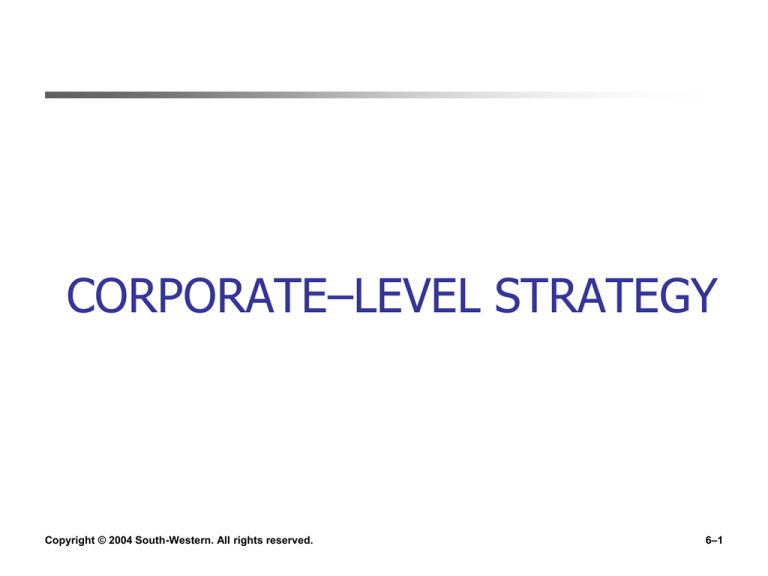
CORPORATE–LEVEL STRATEGY
Copyright © 2004 South-Western. All rights reserved.
6–1
Two Strategy Levels
• Business-level Strategy (Competitive)
Each business unit in a diversified firm chooses
a business-level strategy as its means of
competing in individual product markets
• Corporate-level Strategy (Companywide)
Specifies actions taken by the firm to gain a
competitive advantage by selecting and
managing a group of different businesses
competing in several industries and product
markets
Copyright © 2004 South-Western. All rights reserved.
6–2
The Role of Diversification
• Diversification strategies play a major role
in the behavior of large firms
• Product diversification concerns:
The scope of the industries and markets in
which the firm competes
How managers buy, create and sell different
businesses to match skills and strengths with
opportunities presented to the firm
Copyright © 2004 South-Western. All rights reserved.
6–3
Corporate-Level Strategy: Key Questions
• Corporate-level Strategy’s Value
The degree to which the businesses in the
portfolio are worth more under the management
of the company than they would be under other
ownership
What businesses should
the firm be in?
How should the corporate
office manage the
group of businesses?
Business Units
Copyright © 2004 South-Western. All rights reserved.
6–4
Strategic Motives for Diversification
To Enhance Strategic Competitiveness:
• Economies of scope (related diversification)
Sharing activities
Transferring core competencies
• Market power (related diversification)
Blocking competitors through multipoint competition
Vertical integration
• Financial economies (unrelated diversification)
Efficient internal capital allocation
Business restructuring
Table 6.1a
Copyright © 2004 South-Western. All rights reserved.
6–5
Related Diversification
• Firm creates value by building upon or
extending its:
Resources
Capabilities
Core competencies
• Economies of scope
Cost savings that occur when a firm transfers
capabilities and competencies developed in one
of its businesses to another of its businesses
Copyright © 2004 South-Western. All rights reserved.
6–6
Related Diversification: Economies of Scope
• Value is created from economies of scope
through:
Operational relatedness in sharing activities
Corporate relatedness in transferring skills or
corporate core competencies among units
• The difference between sharing activities
and transferring competencies is based on
how the resources are jointly used to create
economies of scope
Copyright © 2004 South-Western. All rights reserved.
6–7
Sharing Activities
• Operational Relatedness
Created by sharing either a primary activity such
as inventory delivery systems, or a support
activity such as purchasing
Activity sharing requires sharing strategic
control over business units
Activity sharing may create risk because
business-unit ties create links between outcomes
Copyright © 2004 South-Western. All rights reserved.
6–8
Transferring Corporate Competencies
• Corporate Relatedness
Using complex sets of resources and capabilities
to link different businesses through managerial
and technological knowledge, experience, and
expertise
Copyright © 2004 South-Western. All rights reserved.
6–9
Corporate Relatedness
• Creates value in two ways:
Eliminates resource duplication in the need to
allocate resources for a second unit to develop a
competence that already exists in another unit
Provides intangible resources (resource
intangibility) that are difficult for competitors to
understand and imitate
A
transferred intangible resource gives the
unit receiving it an immediate competitive
advantage over its rivals
Copyright © 2004 South-Western. All rights reserved.
6–10
Related Diversification: Market Power
• Market power exists when a firm can:
Sell its products above the existing competitive
level and/or
Reduce the costs of its primary and support
activities below the competitive level
Copyright © 2004 South-Western. All rights reserved.
6–11
Related Diversification: Market Power
• Multipoint Competition
Two or more diversified firms simultaneously
compete in the same product areas or
geographic markets
• Vertical Integration
Backward integration—a firm produces its own
inputs
Forward integration—a firm operates its own
distribution system for delivering its outputs
Copyright © 2004 South-Western. All rights reserved.
6–12
Related Diversification: Complexity
• Simultaneous Operational Relatedness and
Corporate Relatedness
Involves managing two sources of knowledge
simultaneously:
Operational forms of economies of scope
Corporate forms of economies of scope
Many such efforts often fail because of
implementation difficulties
Copyright © 2004 South-Western. All rights reserved.
6–13
Unrelated Diversification
• Financial Economies
Are cost savings realized through improved
allocations of financial resources
Based on investments inside or outside the
firm
Create value through two types of financial
economies:
Efficient internal capital allocations
Purchasing other corporations and
restructuring their assets
Copyright © 2004 South-Western. All rights reserved.
6–14
Unrelated Diversification (cont’d)
• Efficient Internal Capital Market Allocation
Corporate office distributes capital to business
divisions to create value for overall company
Corporate
office gains access to information
about those businesses’ actual and
prospective performance
Conglomerates have a fairly short life cycle
because financial economies are more easily
duplicated by competitors than are gains from
operational and corporate relatedness
Copyright © 2004 South-Western. All rights reserved.
6–15
Unrelated Diversification: Restructuring
• Restructuring creates financial economies
A firm creates value by buying and selling other
firms’ assets in the external market
• Resource allocation decisions may become
complex, so success often requires:
Focus on mature, low-technology businesses
Focus on businesses not reliant on a client
orientation
Copyright © 2004 South-Western. All rights reserved.
6–16
Examples:
• Related Diversification
- AT&T acquisition of BellSouth in 2007 as a means of entry
into Internet video service to better compete with cable
companies that already offer bundles of TV, phone, and
Internet services.
- Seagate Technology moving into data back-up and archival
services for SMEs
• Unrelated diversification
- Samsung: global market share leadership in cell phones
(10%); big-screen TVs (32%); MP3 players (13%); DVD players
(11%); and microwave ovens (25%).
- Wal-mart is moving into mortgages, home-equity credits,
consumer loans; and insurance
- GE and Walt Disney have been successful too.
Copyright © 2004 South-Western. All rights reserved.
6–17
The Curvilinear Relationship between
Diversification and Performance
Figure 6.3
Copyright © 2004 South-Western. All rights reserved.
6–18
Internal Incentives to Diversify
Low
Performance
Uncertain
Future Cash
Flows
Synergy and
Risk
Reduction
• Synergy exists when the value
created by businesses working
together exceeds the value created
by them working independently
• … but synergy creates joint
interdependence between business
units
• A firm may become risk averse and
constrain its level of activity sharing
• A firm may reduce level of
technological change by operating in
more certain environments
Copyright © 2004 South-Western. All rights reserved.
6–19
Resources and Diversification
• A firm must have both:
Incentives to diversify
Resources required to create value through
diversification
Cash
Tangible resources (e.g., plant and equipment)
• Value creation is determined more by
appropriate use of resources than by
incentives to diversify
Copyright © 2004 South-Western. All rights reserved.
6–20
Mergers, Acquisitions, and Takeovers:
What are the Differences?
• Merger
A strategy through which two firms agree to integrate their
operations on a relatively co-equal basis
• Acquisition
A strategy through which one firm buys a controlling, or
100% interest in another firm with the intent of making the
acquired firm a subsidiary business within its portfolio
• Takeover
A special type of acquisition when the target firm did not
solicit the acquiring firm’s bid for outright ownership
Copyright © 2004 South-Western. All rights reserved.
6–21
Reasons for Acquisitions
1. Increased market power (through horizontal,
vertical or related diversifications)
2. Overcoming entry barriers
3. Lower risk compared to developing new products
4. Learning and developing new capabilities
5. Avoiding excessive competition
6. Increased diversification
7. Cost of new product development / speed to
market
Copyright © 2004 South-Western. All rights reserved.
6–22
Problems in Achieving Success through
Acquisition
1.
2.
3.
4.
5.
6.
7.
Integration difficulties
- cultures/systems/leadership styles/loss of key personnel
Large or extraordinary debt
Inadequate evaluation of target (inadequate due diligence
may lead to paying premium)
Inability to achieve synergy
Too large
Too diversified
- rely too much on financial rather than strategic control;
must process more and diverse info; acquisitions
substitute innovation.
Managers overly focused on acquisitions
- managers invest too much time and energy on
acquisitions; managers of target firm may not commit to
long-term decisions.
Copyright © 2004 South-Western. All rights reserved.






